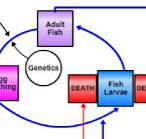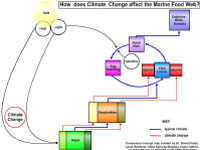|
|
Click Images to Enlarge
|
||||||||
About this Workshop:
For this workshop, 15 graduate students from UMaine and 2 post-doctoral researchers were matched with New England-region ocean and climate scientists to improve their collective understanding of Earth's major ocean - climate systems. [more]
About this Scientist:
David Fields is a marine biologist in general, and more specifically, a chemo- and mechano-sensory ecologist. He studies the environmental factors (chemicals, physical movement) that influence plankton behaviors at the small scales at which plankton live (micrometers to meters).
Dave's research projects investigate the role of chemical and fluid mechanical signals in mediating zooplankton behavior. He is interested in the fine scale structure of signals, how signals are detected, zooplankton behavioral responses to fluid signals, and how zooplankton behavior is manifested in their local and global distribution. This work combines small-scale fluid mechanics, neurophysiology and animal behavior and information derived from examining small-scale interactions is applied towards understanding plankton large-scale distribution patterns. [more]














